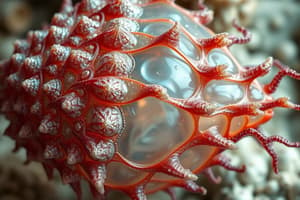Podcast
Questions and Answers
What is the Class Polyplacophora commonly known as?
What is the Class Polyplacophora commonly known as?
- Snails
- Clams
- Chitons (correct)
- Octopuses
What are the characteristics of chitons?
What are the characteristics of chitons?
Reduced head & flattened foot; mantle extends beyond plates; gills within mantle cavity for gas exchange; herbivores scrape algae with radula.
Which of the following classes includes snails, limpets, and slugs?
Which of the following classes includes snails, limpets, and slugs?
- Class Gastropoda (correct)
- Class Cephalopoda
- Class Polyplacophora
- Class Bivalvia
What is the unique feature of the gastropod's digestive system?
What is the unique feature of the gastropod's digestive system?
Why is torsion beneficial for gastropods?
Why is torsion beneficial for gastropods?
What is the primary locomotion method for gastropods?
What is the primary locomotion method for gastropods?
How do marine gastropods perform gas exchange?
How do marine gastropods perform gas exchange?
What is the primary feeding strategy of bivalves?
What is the primary feeding strategy of bivalves?
Which of the following classes include octopuses, squids, and cuttlefish?
Which of the following classes include octopuses, squids, and cuttlefish?
What circulatory system do cephalopods possess?
What circulatory system do cephalopods possess?
What modifications do cephalopods have for movement?
What modifications do cephalopods have for movement?
Flashcards are hidden until you start studying
Study Notes
Class Polyplacophora
- Known as chitons, primitive mollusks with eight articulated plates forming their shell.
- Exhibit a low profile, adapted for a rocky environment.
Chiton Characteristics
- Features a reduced head and a flattened foot.
- The mantle extends beyond the plates, with a limited mantle cavity.
- Gills located within the mantle cavity facilitate gas exchange.
- Utilize a radula to scrape algae, feeding primarily as herbivores.
Class Gastropoda
- Includes snails, limpets, and slugs found in marine, freshwater, and terrestrial habitats.
Gastropod Characteristics
- Typically possess a single, often coiled shell.
- Exhibits torsion, a unique developmental twist.
Torsion in Gastropods
- Involves a 180-degree twisting of the visceral mass during embryonic development.
- Results in a twisted U-shaped digestive tract and placement of gills, anus, and reproductive openings behind the head.
Hypothesis for Torsion
- Provides protection by allowing the head to withdraw into the shell first, followed by the foot, which can then close off with an operculum.
Gastropod Locomotion
- Movement is achieved through pedal waves generated by a flattened, ciliated foot covered in mucous.
- Variations exist: clinging adaptations in abalone and limpets, or swimming adaptations in sea butterflies and sea hares.
Marine Gastropods - Gas Exchange
- Possess one or two gills; burrowing species develop a siphon for water intake, aiding in gill function.
Terrestrial Gastropods - Gas Exchange
- Often have reduced or absent gills; the highly vascularized mantle cavity performs gas exchange.
Gastropod Diversity
- Shelled (e.g., snails, limpets, abalones) represent the largest group.
- "Shell-less" forms (e.g., slugs, sea hares) utilize prey defenses such as spicules, nematocysts, or ink for protection.
Class Bivalvia
- Includes clams, oysters, mussels, and scallops found in marine and freshwater habitats.
- Characterized by two hinged shells (valves) and absence of a head or radula.
Bivalve Characteristics
- Act as filter feeders, using gills for gas exchange and feeding.
- The nervous system consists of three nerve clusters for movement-related functions.
Bivalve Diversity - Burrowers
- Some bivalves bury themselves in mud, using a muscular foot to dig, while others attach to substrates with a reduced foot.
Bivalve Diversity - Swimmers
- Swim by flapping their valves, utilizing a reduced foot.
Bivalve Diversity - Borers
- Secrete acid to dissolve substrate and create burrows.
Bivalve Diversity - Symbiotes
- Engage in symbiotic relationships, deriving nutrients from internal algae.
Class Cephalopoda
- Comprises octopuses, squids, cuttlefish, and nautiluses; known as the most complex mollusks.
Cephalopod - Nautilus
- The only living cephalopod with an external shell, featuring fluid-filled chambers for buoyancy control.
Cephalopod - Cuttlefish
- Possesses a thin, internal 'cuttlebone' with gas-filled spaces to enhance buoyancy.
Cephalopod - Squid
- Features a reduced internal shell made of chitin known as a pen.
Cephalopod - Octopus
- Lacks a shell entirely, possessing high adaptability traits.
Cephalopod Characteristics
- Fast, agile predators with large brains and advanced senses.
- Foot modified into tentacles for locomotion, predation, and reproduction; siphon allows for jet propulsion by expelling water.
Feeding Mechanism in Cephalopods
- Capture prey using adhesive tentacles, equipped with crushing jaws (beaks) and radula for tearing food.
Circulatory System of Cephalopods
- Possess a closed circulatory system that is unique among mollusks, maintaining blood within vessels.
- Feature three hearts: one main heart and two supporting hearts near the gills, facilitating high blood pressure and circulation efficiency.
Studying That Suits You
Use AI to generate personalized quizzes and flashcards to suit your learning preferences.




